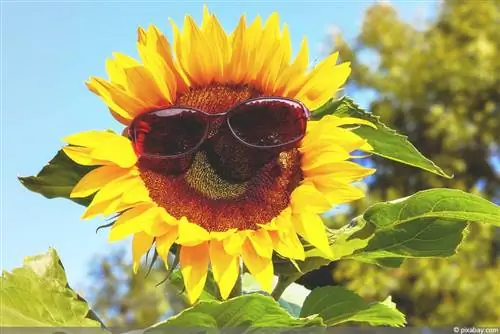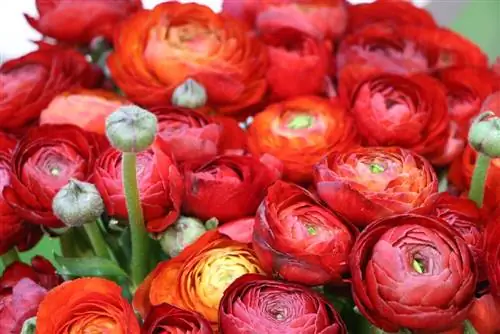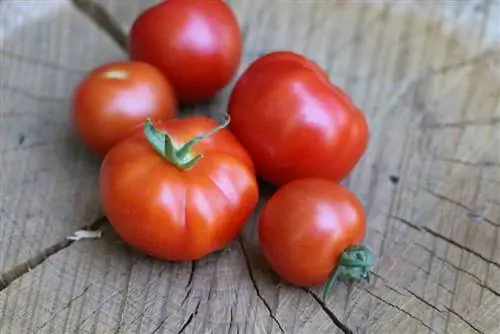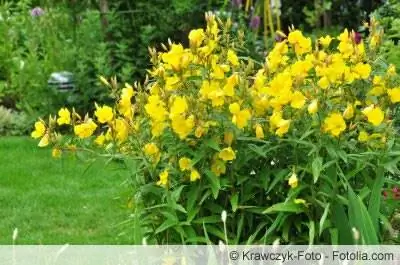- Author admin [email protected].
- Public 2023-12-17 03:39.
- Last modified 2025-06-01 06:48.
If you want to cultivate sunflowers in your garden, the plants make it relatively easy. They bloom from July to September in many beds or in tubs and pots on terraces and balconies and always stretch their thick yellow flowers towards the sun. There are many different types, but they hardly differ in terms of sowing and care. Thick flowers or a multitude of smaller yellow or orange-red flowers decorate the local gardens.
Preparation
The hobby gardener should prepare for the next sowing of his sunflowers as early as autumn. Then the sunflower seeds are harvested from the dried flowers and spread out on a large piece of cardboard to dry in a warm, dry place, such as the boiler room. The sunflower seeds can be left in a warm place or in a dry flower. So they will be ready for sowing in April of next year.
Sowing
Sunflowers can be easily cultivated by sowing. This works in the garden bed as well as in the pot on the terrace or balcony. Of course, the flowers can also be grown indoors before the gardening season begins. However, this is actually not necessary and just as good, if not better, results will be achieved if the seeds are placed directly into the soil at their final location. From sowing to the first flowering, you can expect a waiting time of around eleven weeks. Once the ground has warmed to around 7° to 8° Celsius in April, the first sowing can begin. You should proceed as follows:
- Determine rows about 75 cm apart
- The planting distance should be about 45 cm in the rows
- The seeds must be planted about 4 - 6 cm deep in the ground
- If the seeds should be sown at staggered times, leave more space between the individual seeds
- so the next seeds can be sown here later in between
- If sunflowers are grown in pots, sow a maximum of two flowers together
- It is better to sow only one sunflower in each pot
- more seeds can be put into the bucket at the beginning
- but remove the weaker seedlings from this later
- the bucket should be at least 35 cm in diameter
- As soon as the seeds have been sown, further care must also begin
Tip:
If you want to enjoy the graceful sunflowers blooming for a long time, sow them at different times. This means that the next flowers will start to bloom when the first ones are already wilting. A time interval of one week is ideal for sowing here.
Plants
If the sunflower seeds are sown in small pots and kept indoors to germinate, then when they have grown larger, they must be planted in their future place. Not much needs to be taken into account:
- Water bales sufficiently
- dig a sufficiently large hole in the open field or in a bucket
- Insert sunflower and water well
Tip:
If you have a lot of friends and are often invited to garden parties in the summer, you can sow small souvenirs in small pots in the spring. In spring or early summer, a finished, small sunflower will develop that can be given to a host as a gift.
Location
As the name suggests, sunflowers are sun worshipers and therefore want a sunny location. The location should also be protected from the wind, as the flowers grow very tall and are then at risk of the stems bending or, in the worst case, even breaking in the wind. Therefore, the following locations are ideal for sunflowers:
- in front of a sunny wall
- in front of a high fence
- on a trellis to which they are tied and thus supported
Tip:
If the sunflowers are sown in the open ground, they should be stabilized with a sufficiently high stick when they are half-grown so that they do not break when they are fully grown and the flower heads have become quite heavy.
Substrate & Soil
Sunflowers need a lot of nutrients right from the start so that they can grow as high as possible and the flower heads also get nice and big and can compete with the sun. It is therefore essential to prepare the soil at the location well before sowing the sunflower seeds:
- deep and humus-rich soil
- If the soil is too sandy, the sunflowers will need more fertilizer later
- mix sandy soil with horn shavings or compost to make it more nutrient-rich
Watering & Fertilizing
Sunflowers need a lot of water right from the start; the soil in which they are sown must never become dry. This applies equally to garden beds and pots. However, they cannot tolerate waterlogging, so care must be taken, especially with potted plants, to ensure that no moisture accumulates in the saucer. Ideally, for potted plants, a drainage made of potsherds or gravel and plant fleece is created over the drainage hole before soil and seeds are added. Other things you should pay attention to when watering and fertilizing so that the sunflowers will delight you with abundant blooms in summer:
- If it is sunny and warm, you have to water it daily
- Since the flowers are located in the blazing sun, they should only be watered in the early morning or late evening hours
- On particularly hot days, it is even recommended to water in the morning and evening
- the potted plants in particular should not be forgotten, as the water in the pot evaporates even faster due to the sunlight
- hanging leaves and heads indicate lack of water
- Stinging nettle manure or commercial liquid fertilizer enriched with nitrogen, boron and potassium are suitable as fertilizer
- Give fertilizer with the irrigation water once or twice a week
Tip:
When it comes to sunflowers, the motto is, more is more. If the graceful plants are given too little fertilizer or water, they and the flowers remain small and do not grow properly.
Cutting
Sunflowers do not require pruning as they are annuals. After they have faded, they are pulled out of the soil with their stems and roots and disposed of in the compost. However, if you want to make provisions for next year, cut off the flowers with the seeds before disposal and let them dry in a warm place so that you can harvest the sunflower seeds later.
Tip:
If you don't need all the seeds in one summer, you can also distribute the dried flowers with the seeds at feeding places in the garden for the local birds to use in the winter. The birds then pick the sunflower seeds out of the flowers.
Propagate
Sunflowers are propagated by seeds. This is quick and easy. Even sunflower seeds from bird seed sprout quite reliably. It is sown in early spring, preferably outdoors. This goes from April until May. Of course you can also prefer them and plant them out later. You can also grow sunflowers in pots. Although the plants remain smaller, they become quite attractive.
When sowing outdoors, it is recommended to maintain a planting distance of at least half a meter.

With good care, sunflowers can grow very large and strong. There are real competitions for the largest specimens. If you don't value particularly large flower heads, you should choose sunflowers with several flowers. Flowering lasts longer and you get more of the plants.
Care errors, diseases or pests
With good fertilization, the flower heads of sunflowers can become so heavy that they break off. If the hobby gardener notices that the stems have collapsed below the flower, they can still be saved by splinting them here. To do this, a bamboo stick is fixed at the break point with adhesive tape so that the flowers have enough support and continue to grow. Even if the sunflowers are quite robust, they can be attacked by some diseases:
- various mushrooms
- Powdery mildew
- Pests such as aphids, cicadas or spider mites
Conclusion
If you want to compete with your neighbors for the most beautiful sunflowers, it won't be difficult to achieve this. The graceful sun worshipers are sown with last year's sunflower seeds. Sowing is not difficult and can be done directly at the location in the garden bed or container. Caring for the annual plants is also relatively easy; if they receive enough water and fertilizer, they will delight in the garden with their tall growth and beautiful, thick flowers.






